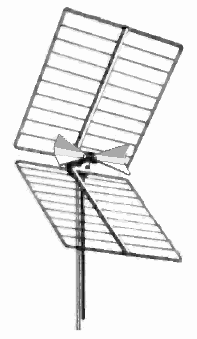
A corner reflector antenna is a type of directional antenna used at VHF and UHF frequencies.[1][2] It was invented by John D. Kraus in 1938.[3][4] It consists of a dipole driven element mounted in front of two flat rectangular reflecting screens joined at an angle, usually 90°.[1] Corner reflector antennas have moderate gain of 10–15 dB,[2] high front-to-back ratio of 20–30 dB, and wide bandwidth.
Corner reflector antennas are widely used for UHF television receiving antennas, point-to-point communication links and data links for wireless WANs, and amateur radio antennas on the 144, 420, and 1296 MHz bands.[2] They radiate linearly polarized radio waves and can be mounted for either horizontal or vertical polarization.
The corner reflector antenna should not be confused with a corner reflector, a passive device used to reflect radio waves back toward the source.
- ^ a b Stutzman, Warren L.; Thiele, Gary A. (2012). Antenna Theory and Design. John Wiley and Sons. pp. 192–194. ISBN 978-0-470-57664-9.
- ^ a b c Straw, R. Dean (2000). The ARRL Antenna Book (19 ed.). American Radio Relay League. pp. 18.9–18.11. ISBN 0-87259-817-9.
- ^ Kraus, John D., US patent 2270314, Corner reflector antenna, filed January 31, 1940; granted January 20, 1942.
- ^ Kraus, John D. (1988). Antennas (PDF) (2 ed.). Tata-McGraw Hill. pp. 549–560. ISBN 0-07-035422-7.
